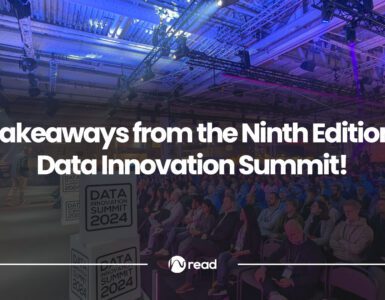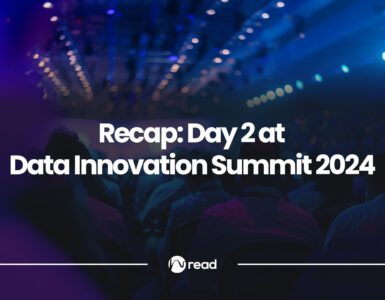In this interview, we had the privilege to talk with Gabor Harsanyi, Head of Connected Data and Analytics at Ericsson AB. With over two decades of expertise in strategy, business intelligence, marketing analytics, customer insights, and data science, his domain knowledge spans across ICT and financial verticals. Notably, Gabor possesses the ability to communicate effectively with both technical and non-technical stakeholders. He adeptly translates complex data into actionable insights that drive strategic decisions.
As a featured speaker on the Business and Data Analytics Stage, Gabor Harsanyi will delve deeper into the topic of “Show me the money! – The ROI of marketing analytics” at the upcoming Data Innovation Summit 2024.
Hyperight: Can you tell us more about yourself and your organization? What are your professional background and current working focus?


Gabor Harsanyi: My name is Gabor Harsanyi, and I currently serve as the Head of Connected Data and Analytics at the Marketing and Corporate Relations (M&CR) unit in Ericsson. In this capacity, I oversee the M&CR Data Strategy, the Measurement Strategy, and the CRM Strategy. Additionally, I hold a secondary role as the Marketing Data Domain Manager. I possess in-depth domain knowledge in marketing, IT, and finance. I dedicate myself to helping my stakeholders translate data into actionable insights.
Hyperight: During the Data Innovation Summit 2024, you will share more on “Show me the money! – The ROI of marketing analytics”. What can the delegates at the event expect from your presentation?
Gabor Harsanyi: In recent years, data-driven marketing has been a buzzword for most enterprises. Today, companies have come to recognize the value of data and analytics. However, there is still debate over whether analytics and measurement can truly deliver tangible business value across the entire company. The impact is evident in B2C eCommerce. However, the challenge lies in proving the ROI for executives in B2B, where sales cycles are long and complex.
My goal is for delegates to grasp the challenges associated with bottom-up measurement and to present a clear path from metrics through Key Performance Indicators (KPIs) to Objectives and Key Results (OKRs). I aim to share real-life examples that not only demonstrate how marketing activations contribute to marketing success but also highlight their contribution to the overall enterprise business value. This represents a shift in mindset from focusing on vanity metrics to prioritizing business impact.
Hyperight: Could you tell us more about Ericsson AB and how the company has integrated analytics into its decision-making processes? What key milestones has the company achieved in this journey?
Gabor Harsanyi: As my function is within the M&CR unit, I focus on this field. Considering the size of Ericsson and the M&CR unit, this approach is easily adaptable to other companies as well. My team and its function are relatively young, being only three years old. The team was established with a primary emphasis on data and measurement. I nurtured the team and its approach from scratch, starting with the formulation of the M&CR Data Strategy and simultaneously creating the Measurement Strategy.
I composed mission statements during specific periods in my data and analytics strategies that have driven and continue to drive our journey. The message of the initial period was: “We translate numbers into actionable insights,” with a focus on dashboard development and insights delivery. The subsequent time frame centered around upskilling non-data individuals for self-service analytics, supported by the aforementioned dashboards (“Teach a person to fish, and you feed them for a lifetime”). Currently, we are in the “Show me the money!” phase, delving into Analytics ROI and Connected Insights. I use the analogy of the “Butterfly Effect” borrowed from chaos theory, to illustrate this period.
At the pinnacle, I aspire to achieve “Let the robots take away our work, but not our job.” This symbolizes the rollout of AI-driven analytics. Each mission statement has been accompanied by various milestones. These include implementing data strategy use cases, delivery of insightful dashboards, creation of D&A education pathways, establishment of a Data and Analytics Community for non-data individuals, and the transition from a center of excellence to a strategy team.
Hyperight: How would you describe the evolution of this journey so far, what are the learning points for Ericsson AB today? What was the starting point, where are you now, and what is next?
Gabor Harsanyi: It has been an exciting journey filled with numerous learning experiences – and it‘s not over yet. To illustrate this journey, I would like to borrow an analogy with pride from Elisabeth Kübler-Ross: the five stages of grief applied to marketing data. The stages that non-data teams typically go through are denial, anger, bargaining, depression, and acceptance. To overcome these challenges, we need to focus on five key elements to enhance data literacy.
The most crucial component is executive buy-in. Additionally, we require a community to foster data literacy and expand the supporters of the data and analytics approach. We need a dedicated person to upskill non-data individuals. Condensed messages, expressed as “mantras”, are essential for effective communication. Finally, we can turn our attention towards ROI.
It’s worth noting that the data-driven approach is becoming obsolete and businesses are replacing it with the data-informed approach. In this approach, decision-makers don’t solely rely on hard data facts. Instead, they supplement their messages with emotional storytelling supported by qualitative insights and place greater emphasis on intuition and experience.
The journey began with the bottom-up analytics method, a common starting point for many companies. Although we recognize the benefits of transitioning to a top-down approach for the enterprise, it remains challenging to move beyond the denial phase. This is until there is a solid foundation of data and analytics capabilities and understanding within non-data teams.
Hyperight: What resources and tools were essential for initiating and sustaining this journey?
Gabor Harsanyi: At M&CR, we leverage a MarTech stack with 50+ tools, encompassing all our analytics needs. We migrated our data to a data lake and actively collaborate with other data domains across the company.
Hyperight: In your experience, what are some challenges organizations face when attempting to measure the return on investment for their marketing analytics initiatives, and how can these challenges be addressed?
Gabor Harsanyi: Arguably, the most significant challenge lies in demonstrating the value of marketing to individuals outside the marketing sphere. Marketing and communications encompass numerous intangible assets such as brand score, reputation, and media sentiment. Translating these into the language of finance or sales can be challenging. It is essential to identify the connection between marketing metrics and business metrics. Moreover, when using complex composite metrics, there is a high risk of losing the interest of your immediate audience. This risk is particularly significant if they lack marketing domain knowledge.
Hyperight: What recommendations would you offer to individuals or organizations considering embarking on a similar journey, drawing from your experience and lessons learned?
Gabor Harsanyi: Always begin the journey by conducting an audit to understand the data and analytics capabilities of your organization. For mature teams, use the top-down approach. Identify metrics, likely OKRs, that contribute to the company’s overall success. Then, continue by cascading those metrics down to the different units and teams. For less mature teams, the bottom-up approach is more beneficial to establish a data-driven mindset and promote growth. However, it does not directly support the overall company objectives.
Hyperight: Looking ahead, what analytics trends can we expect in the upcoming 12 months, and how can businesses leverage these trends for enhanced return on investment?
Gabor Harsanyi: Data quality and data democratization will remain the focus of enterprise data strategies. There will be a gradual shift from a data-driven to a data-informed approach. Executives realize that data alone is not sufficient for comprehensive insights. B2B corporates are increasingly adopting the analytics ROI approach. This is due to the challenging global economic situation and the need to be mindful of cost levels. Therefore, we need to connect insights to the company’s success instead of leaving them standalone, scattered, or local. Transparency will be a competitive advantage for companies, as it is becoming more difficult to conceal information, and doing so can negatively impact reputation. It pays to be as transparent as possible.
Disclaimer: The views and opinions expressed herein are solely those of the individual and do not necessarily reflect the views or opinions of the company.
For the newest insights in the world of data and AI, subscribe to Hyperight Premium. Stay ahead of the curve with exclusive content that will deepen your understanding of the evolving data landscape.















Add comment